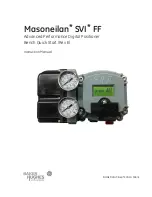
5-14
EB 8075 EN
Installation
cessories not fitted with noise-reducing fit-
tings. Both can damage hearing.
Î
Wear hearing protection when working
near the valve.
Crush hazard arising from moving parts
(actuator and piston stem).
Î
Do not insert hands or finger into the
yoke while the air supply is connected to
the actuator.
Î
Before working on the control valve, dis-
connect and lock the pneumatic air sup-
ply as well as the control signal.
Î
Do not impede the movement of the actu-
ator and piston stem by inserting objects
into the yoke.
Î
Before unblocking the actuator and pis-
ton stem after they have become blocked
(e.g. due to seizing up after remaining in
the same position for a long time), re-
lease any stored energy in the actuator
(e.g. spring compression). See associat-
ed actuator documentation.
Risk of personal injury due to exhaust air
being vented.
While the valve is operating, air is vented
from the actuator, for example, during
closed-loop operation or when the valve
opens or closes.
Î
Wear eye protection when working in
close proximity to the control valve.
Risk of personal injury due to preloaded
springs.
Actuators with preloaded springs are under
tension. They can be identified by the long
bolts protruding from the bottom of the actu-
ator.
Î
Before starting any work on the actuator,
relieve the compression from the pre-
loaded springs (see associated actuator
documentation).
To test the valve functioning before start-up
or putting back the valve into operation, per-
form the following tests:
5.4.1 Leak test
The plant operator is responsible for per-
forming the leak test and selecting the test
method. The leak test must comply with the
requirements of the national and internation-
al standards that apply at the site of installa-
tion.
Our after-sales service can support you to
plan and perform a leak test for your plant.
1. Close the valve.
2.
Slowly apply the test medium to the inlet
space upstream of the valve. A sudden
surge in pressure and resulting high flow
velocities can damage the valve.
3. Open the valve.
4. Apply the required test pressure.
WARNING
!
WARNING
!
WARNING
!
WARNING
!
WARNING
!
Tip
Summary of Contents for EB 8075 EN
Page 28: ...3 14 EB 8075 EN...
Page 34: ...4 6 EB 8075 EN Shipment and on site transport...
Page 58: ...8 4 EB 8075 EN...
Page 60: ...9 2 EB 8075 EN...
Page 66: ...12 2 EB 8075 EN...
Page 68: ...13 2 EB 8075 EN...
Page 70: ...14 2 EB 8075 EN...
Page 77: ......
Page 78: ......
Page 79: ......


































